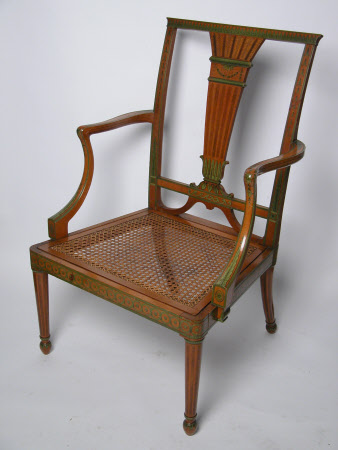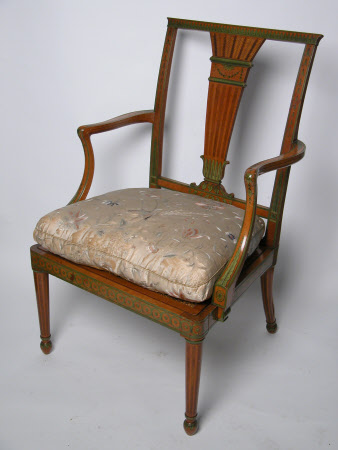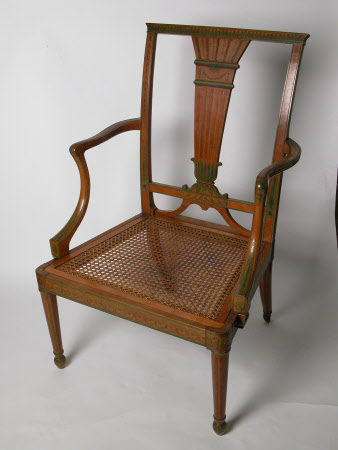Open armchair
probably John Linnell (1729 - 1796)
Category
Furniture
Date
circa 1779
Materials
Beech, satinwood, rosewood, paint, cane
Measurements
93.5 x 60 x 58 cm
Place of origin
Berkeley Square
Order this imageCollection
Osterley Park and House, London
NT 771800.13
Summary
An open armchair, one of a set of thirteen, of beech veneered in satinwood, and with rosewood inlaid and painted decoration, probably by John Linnell (1729-96), cabinet-maker of Berkeley Sq., London, circa 1779. This chair (.13) stamped ‘H. BYTHAM’ to its underside; another (.6) with scratched initials ‘HB’. Having a straight toprail with cavetto upper corners painted with stiff unlobed acanthus leaves, above a splat formed as a quiver of arrows, the fletching painted and engraved at the top, and with astragal mouldings framing a section painted with a husk festoon. The quiver painted with trailing husks, lotus and acanthus and inlaid with flutes. The base of the splat painted with opposing runs of Vitruvian scrolls and raised up on a pair of open ‘shoe’ spars. The cane slip seat between open arms on incurved supports, painted with acanthus and a patera at the junction with the seat rails, which are painted with a band of guilloche. Raised on turned legs inlaid with flutes and with turned feet painted with ‘grass’.
Full description
Robert Adam’s (1728-92) last known design for furniture at Osterley, dated April 1779, was for the painted and gilded satinwood bed still in the Yellow Taffeta Bedchamber. Other furniture, including these chairs (a set of thirteen in the bedroom and its adjoining Dressing Room) were made, probably by John Linnell (1729-96) to his own designs, to match. The chairs were described in an inventory taken in 1782 as ‘Elbow Satinwood Chairs inlaid and Japanned cane seats’. The chairs in the Dressing Room had cushions ‘covered with yellow Satin needlework and stripe cases’ and in the Bedroom with ‘Taffaty [taffeta] fringed to match’. Painted and inlaid with restrained marquetry – in contrast to the bolder large-scale marquetry of furniture made in the 1760s and early 1770s – the chairs are in the late neo-Classical style, anticipating the simpler lines and plainer styles of the late 18th and early 19th centuries. Although John Linnell is thought to have worked in the furniture trade until around 1793 (he died in 1796), very little furniture firmly attributed to him after 1780 survives. Robert Child died in 1782, just two years after this chair was made. Bills survive showing that Linnell’s firm worked for his widow, Sarah Child (d. 1793), in 1782 and 1783 at her house in Berkeley Square, making repairs, re-arranging rooms and even ‘sweeping the snow off the top of the house and cleaning the gutters’. One of the chairs in this set bears the name ‘H. BYTHAM’ to its underside, another the conjoined initials ‘HB’. This is highly unusual for furniture made by Linnell. It may refer to an employee of his, a journeyman, or the man responsible for fitting the squab seats with cane. A Henry Bytham was apprenticed to the London cabinet-maker David Blyth (d. 1773) in 1770 and later petitioned to be released from his binding on the grounds of ill-treatment (involving starvation and physical violence) and poor training. This Henry Bytham may have been the cabinet-maker of Margate, Kent, who died in 1831.
Provenance
Osterley Park Heirloom
Marks and inscriptions
Underside of seat rail: H. BYTHAM [stamped]
Makers and roles
probably John Linnell (1729 - 1796), cabinetmaker possibly H. Bytham, maker



